What is Aeroponics?
Aeroponics is a system of growing plants that offers many advantages for marijuana growing. Defined, aeroponics grows plants with their roots suspended in the air in a grow chamber, with no medium, in a closed-loop system. Nutrient-rich water is sprayed on the roots of the plants as they dangle in the air. The microbes on the plant are in an oxygen-rich environment, which allows the microbes time to digest the nutrients and to make them immediately available to the plant’s circulatory system. Well-circulating CO2 in the room allows further enhanced growth.
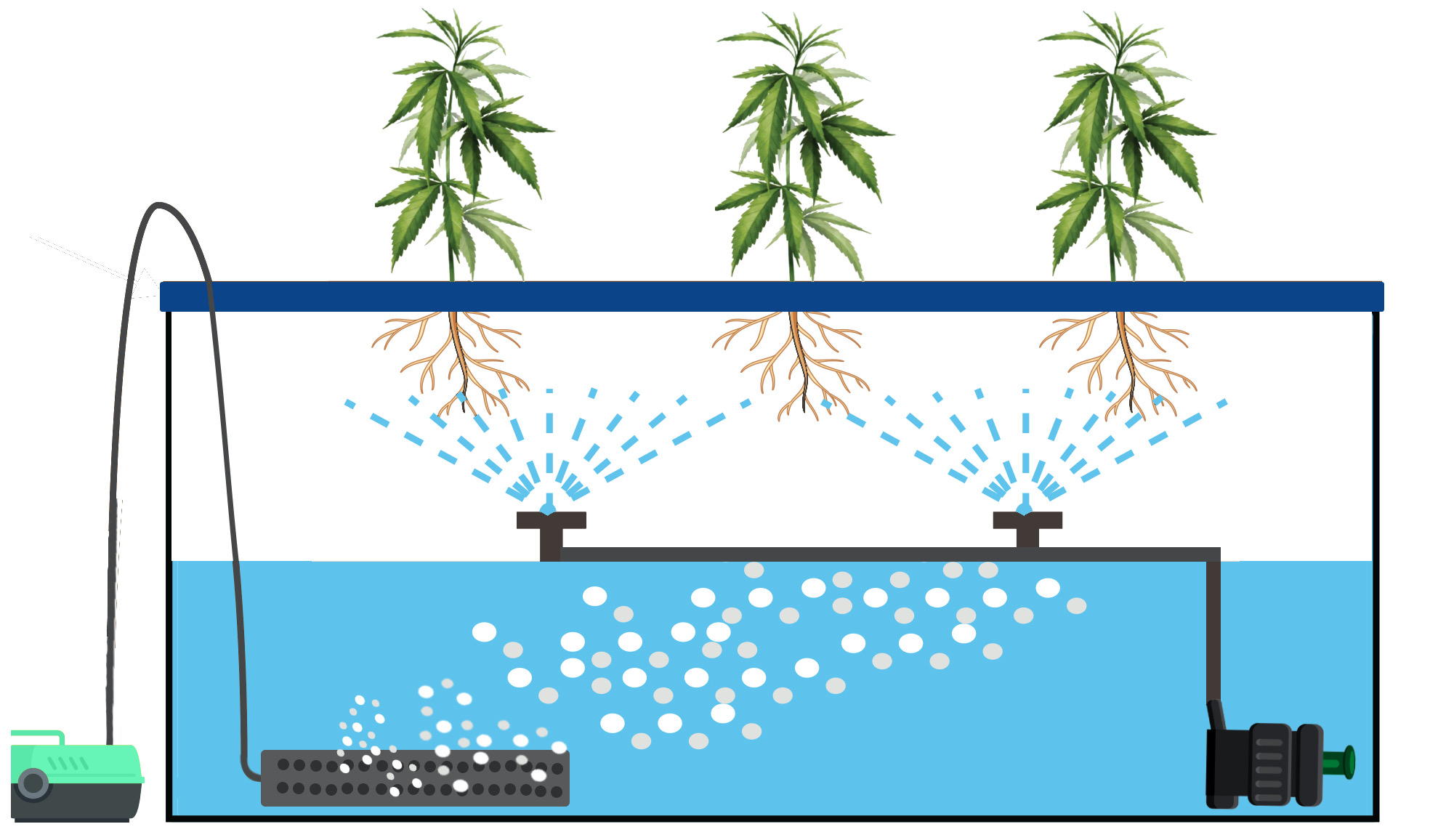
How does aeroponics work?
- Plants are grown in net pots (like those used in deep water culture), hovering over a misting system;
- The plant roots are sprayed with a mixture of water and nutrients at high pressure with on/off intervals;
- The intervals are important to gain the great advantages of growing aeroponically – saving electricity, reducing evaporation and waste, as well as reducing the likelihood of diseases such as root rot.
- The “off” intervals give the plants a downtime that allows the plant time to take up the nutrients into its circulatory system.

Aeroponics uses less water and fewer nutrients than other grow systems. The nutrient-rich water stays in a closed-loop system. A good aeroponic system will have caps over the net pots, allowing only the stem through the caps, which reduces evaporation. This system reduces the risk of the nutrients becoming concentrated too quickly. Light is also prevented from penetrating the root zone, making it almost impossible for algae to thrive. This relatively disease-free environment allows plants to grow at higher densities, so you can grow more plants per square meter than any other system of growth. Your growth will outpace soil growth, as well as hydroponic systems such as DWC, bubbleponics, or nutrient film technique (NFT.)
Aeroponics is not for beginners
A grower should be familiar with how marijuana grows and what a healthy plant looks like so problems become apparent early in the process. If you are not technically inclined, this may not be your system. As an aeroponic grower, you need to feel comfortable replacing misters, pumps, and hoses as necessary to keep your system in good working order.
TAG or FAG and High Pressure or Low-Pressure Aeroponic Systems
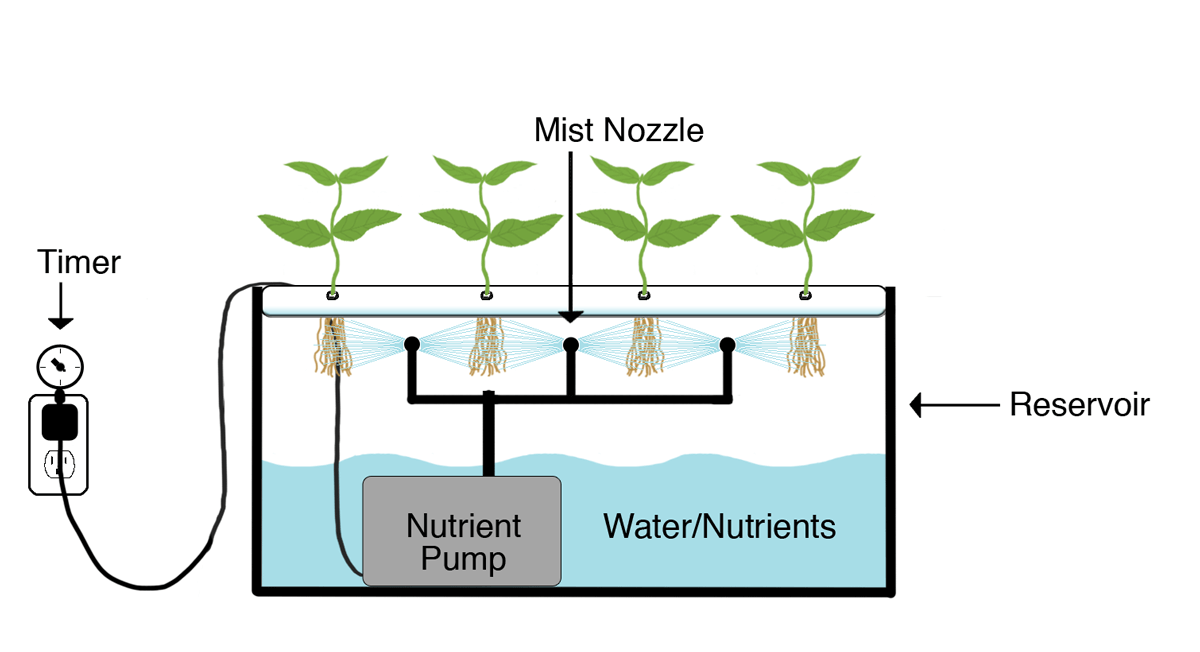
When it comes to aeroponics, there is often debate as to what constitutes a true aeroponic grow (TAG) versus a faux (or fake) aeroponic grow (FAG). Generally, a TAG utilizes mist to contact the plant roots in a grow chamber separate from a reservoir. On the other hand, a FAG may use a spray mist with larger droplets, top-feeding drippers, or other systems that allow the plant roots to grow into the nutrient solution at the bottom of a combined grow chamber and reservoir. A FAG is more accurately referred to as a hybrid system, and most DIY aeroponics systems are low-pressure hybrid systems. TAGs, however, feature a high-pressure pump and mister heads that create a fog in the root chamber, and the reservoir is kept separate from the root chamber.
Bulleted list:
– True Aeroponic Grow (TAG):
– Mist to contact plant roots in the grow chamber separate from the reservoir
– High-pressure pump and mister heads create fog in the root chamber
– Faux Aeroponic Grow (FAG):
– Spray mist with larger droplets
– Top-feeding drippers
– Other systems that allow plant roots to grow into nutrient solution in a combined grow chamber and reservoir
– More accurately referred to as a hybrid system
– Most DIY aeroponics systems are low-pressure hybrid systems
- TAGs are also referred to as high-pressure aeroponic systems (HPS.)
- The fog produced in a TAG/HPS consists of droplets smaller than 50 microns;
- A TAG also uses a cycling timer to spray the nutrients for 1 to 5 seconds and then shut off for 3 to 5 minutes. This short burst of nutrient solution on the roots, coupled with the downtime, will create a root network of tiny root hairs, allowing maximum colonization of microorganisms, which do the work of processing the nutrients into a form that the plant can digest;
- Minimum droplet size + effective on/off misting timing = more root growth = more surface area for microbes = amazing plant growth! (More on this in the section on nutrients later.)
Current Culture Under Current Solo 8 Gallon
Single Module Deep Water Culture (DWC) System
The SOLO Single Module Water Culture System is great for hydro beginners and mother plants. It’s available in both 8 and 13-gallon module sizes with interchangeable CCH2O Lid options. The UC Solo is easy to setup and maintain, start growing trees!
The Under Current® features the patented Sub-Current Culture® circulation method. This high-performance water culture system is unmatched in efficiency, layout versatility and ease of use. The Under Current® utilizes negative water pressure to recirculate oxygenated nutrient solution through the plant’s root zone ensuring pH and EC levels are uniform throughout the entire system.
- Self-Watering, Gravity-Fed System for Grow Tents and Hydroponics
As with all AutoPot Watering Systems, XXL operates power-free, without the need for running water, and without pumps or computers to maintain. Immense savings in time, money, and ecology are obvious merits. Such virtues are equaled only by the responsiveness with which plants are fed and watered. The AQUAvalve5s that regulate every module respond exactly to each individual plant’s needs, supplying water and nutrient solution only as and when required, without recirculation or a drop of waste.
Hydrofarm MGSYS Hydroponic Megagarden Ebb & Flow System in a 22" x 22" x 10" size Container,Black
- Get the convenience of an Ebb & Flow System in a 22" x 22" x10" size garden
- Includes fired-clay and pebble grow media; 7-1/2-gallon reservoir, water level indicator
- Includes fifteen 5-inch, plastic grow pots can be filled with soil, or included fired-clay pebble grow media
- Submersible pump and timer for automatic flood and drain irrigation
- Also features seed starter cubes, nutrients and a pH test kit

Increased Yields
Aeroponic systems have an advantage over traditional indoor hydroponic systems due to extensive root growth, maximum root-zone air circulation, and minimal disease risk. The high oxygen environment also enables massive root growth, scientifically proven to increase yields by up to 10x compared to soil! And with a short veg time, you’ll experience increased yields from healthier plants and more crops per year. Plus, you’ll have the peace of mind that comes with minimal disease risk.
However, the minimal margin of error in an aeroponic system creates a disadvantage.
- For instance, if electrical power stops for any reason, plants will wilt and die rather quickly because there is no water at their roots;
- You’ll need to keep a close eye on your equipment to make sure your plants don’t have dry spots where the mist isn’t reaching the roots – especially as the root system develops;
Aeroponics Step-by-Step Guide



Step 1 – Which Aeroponics System?
Aeroponics is an exciting way to grow plants, and there are many systems you can choose from, depending on the amount of space you have and how much you are willing to spend. For those looking for a more budget-friendly option, the Stealth Aeroponic system is a great choice. For a more professional system, the General Hydroponics Aeroflo2 system is a good option, and the Botanicare Aerojet 4×4 Tray is a higher-end system. No matter which system you choose, it is important to use an external cycling timer for maximum benefits of aeroponics.
Aeroponics is a great way to grow plants, and several systems are on the market to get you started. Depending on the amount of space you have and your budget, you have a few options to choose from:
– DIY or retail version of a DIY – these are hybrid systems with no separate reservoir. An example of this is the Stealth Aeroponic system.
– Aerogarden – an inexpensive starter system with a CFL light designed to grow herbs with shallow roots.
– General Hydroponics Aeroflo2 system – this hybrid system comes in various sizes and is designed to run 24/7.
– Botanicare Aerojet 4×4 Tray – this unit has misters inside the grow chamber and a separate reservoir. It also has a timer with a one-minute on/four minutes offsetting.
No matter which system you choose, it is important to use an external cycling timer for maximum benefits of aeroponics. With the right system, you can have a successful aeroponic garden quickly!
Construct Your DIY System:
You can construct your DIY hybrid aeroponics system in 2 to 3 hours. The cost will vary depending on what materials you have on hand and how much you spend on your timer. This system has 6 plant sites, but you can expand or reduce based on what you want.
Materials needed:
- 25 Gallon Rubbermaid Tote (Rubbermaid brand has plastic that is soft enough to cut easily. Get a dark color so light can’t penetrate the reservoir;
- 4 feet of 3/4″ PVC pipe (get a little extra just in case);
- 1 PVC T shaped connector– 1/2″ threaded bottom, 3/4″ open sides (not threaded);
- 2 PVC T-shaped connectors– 3/4″ open sides;
- 4 PVC 90-degree elbows– 3/4″ open sides;
- 6″ long 1/2″ nipple pipe (look in the section of the hardware store with sprinkler fittings);
- Water Pump– about 275 to 300 GPH;
- 12 sprinkler heads, ¼ inch, 360 degrees circular spray pattern
- 6 net pots, whatever size you want to use (3.75 inches or smaller recommended);
- 6 foam inserts, the same size as net pots;
- PVC primer and glue;
- Teflon plumbers tape (optional for threaded pipe);
- Cycling timer;
The suggested tools for this job are:
- Drill and drill bit – whatever size you need to drill the holes for the sprinkler heads;
- Hole saw jigsaw or small hand saw, or serrated knife (for cutting out holes for the pots in the lid);
- Saw or special pipe cutters for cutting PVC pipe
Instructions:
- ✓ Line up the net pots on the top of the Rubbermaid Tote lid, three on each side of the lid. (depending on how neat you’d like it to look, you may want to space them evenly.) Trace the open end of the mesh pots on the lid with a marker;
- ✓ Cut holes for the pots. Use a hole saw to cut the holes, or start by drilling a large hole into one of the circles you drew, then use a jigsaw or other saw or knife to cut along the inside of the line you made with a marker (you can always cut a giant hole, but you can’t make one smaller.) Cut a notch large enough to fit the pump cord through one of the holes for the pots. Once you are finished cutting out all holes, clear away any plastic debris so it doesn’t end up in your system when you finish;
- ✓ Lay out your fittings in the bottom of the container. Put the 90 degree pipe fittings in each corner. Put a T fitting in the center of each of the two long sides of the rectangle. The T fitting with the threaded ½ inch connector will go between these two T fittings, with the threaded end pointing toward the bottom of the container (this will connect to the pump.)
- ✓ Cut lengths of PVC pipe to connect the fittings. Cut them a little longer than you think necessary – you can always cut them shorter. You’ll have six longer pieces to connect the T fittings to the corner 90-degree fittings and two shorter pieces to connect the two center T fittings with the T fitting pointed toward the bottom of the container.
- ✓ Drill holes for the sprinkler heads in the six longer PVC pipe sections. Clear all debris from the pipes.
- ✓ Dry fit the pipes to the connector fittings and cut the PVC pipe to fit if you need to. Make sure the holes for the sprinkler heads are pointing up toward the top of the container.
- ✓ Prime the interior of the fittings and the exterior of the PVC pipe sections with the PVC primer.
- ✓ Apply PVC glue to each of the pipe ends and slip into the fittings. Keep in mind the angle of the fittings as you are putting things together so that sprinkler head holes are pointing up, the open ends of the fittings are pointed horizontally and the one center T fitting with the threaded end pointing downward. Once you have glued the pipes to the fittings, you have less than a minute to make adjustments before the glue sets.
- ✓ Attach the sprinkler heads to the PVC pipe.
- ✓ Attach the 6 inch, ½ inch diameter nipple to the threaded end of T fitting and to the pump. Use Teflon tape on the threads if you like.
- ✓ Put water in the bottom of the container and test out the system. Make any adjustments needed.
- ✓ Run the electrical cord for the pump through the notch in the lid.
- ✓ Fill the container with water, adjust pH and nutrients.
- ✓ Place the net pots in the lid, fill with enough properly rinsed hydroton to support the plants, and add plants.
- ✓ Plug in the pump to a cycling timer and you are good to go!
Step 2 – Which Grow Lights
When choosing lights, your main concern will be how much heat the lights will generate. You also don’t want the water in your aeroponics system getting too warm. Anything that will raise water temperature beyond 75°F (24°C) needs to be neutralized. If the temperature becomes too hot, you may have to cool your reservoir (or combo reservoir/grow chamber) with an expensive chiller unit.
While it’s possible to use high intensity discharge (HID) lights successfully with an aeroponic system, it is advisable to look to cooler light sources such as CFLs or LEDs. Using cooler lights simply reduces the likelihood that you’ll have to contend with the negative effects of higher room temperatures.
Step 3 – Nutrients
Once you have your lighting system secured, think about nutrients and how you will feed your plants. Whether you choose to grow with synthetic chemicals or with organics (or a combination of both), it is important to remember that less is more. Start by researching what types of nutrients you want to use and what concentrations of those nutrients are recommended by other aeroponic growers using the same nutrient brand. A good rule of thumb is to start with ¼ of the amount the manufacturer recommends.
- Keep an eye on your plants to make sure they aren’t displaying signs of toxicity or deficiency;
- Adjust in small increments rather than larger ones to avoid shock to your plants;
- Remember that nutrients don’t just include the macronutrients— nitrogen (N), phosphorus (P), and potassium (K) — because micronutrients are also essential to the health of the plants;
- Also important are beneficial microorganisms or microbes. All healthy root systems occur because colonies of beneficial microbes have formed on the roots. The microbes process the nutrients into a form that the roots can accept. Consider this before dosing your water with peroxide or other solutions that might harm these microbes. You want to have a symbiotic relationship with these tiny organisms. You don’t want to go to war with them.
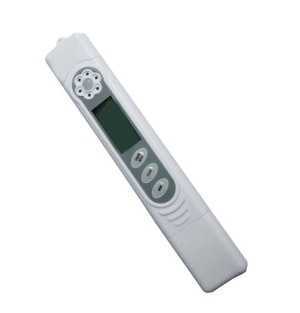
Again, adjust all nutrients in small increments to avoid damaging your crop. Patience in learning how much of your nutrient solution is appropriate for your system will be rewarded with better harvests and easier growth. You’ll need a properly calibrated EC (electrical conductivity) or TDS (total dissolved solids) meter to measure the strength of the nutrients in your reservoir. If you have plant nutrient recommendations in EC units, you should get an EC meter. If your plant nutrient recommendations are in ppm (parts-per-million) values, a TDS meter is best. Remember that the density of your nutrients will increase if water in your system evaporates. If your system does not have caps over the growing medium, you don’t have a closed system, and water will evaporate quickly. It is also possible that light will penetrate your water. Covering unused plant sites on your system can help minimize evaporation and light pollution.
Step 4 – Water
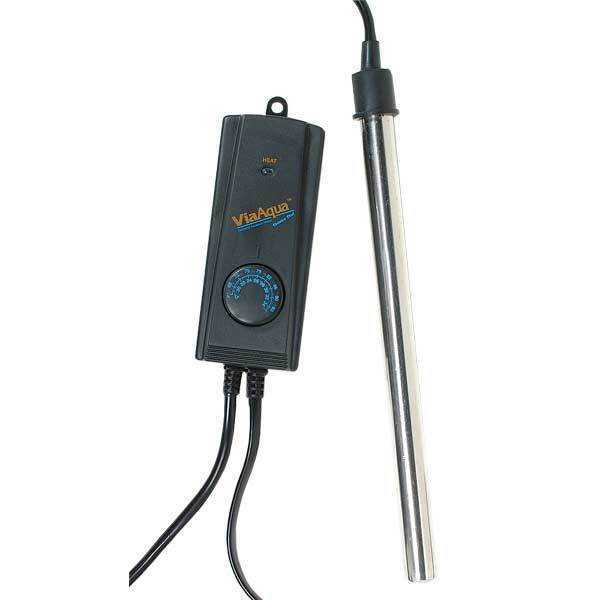
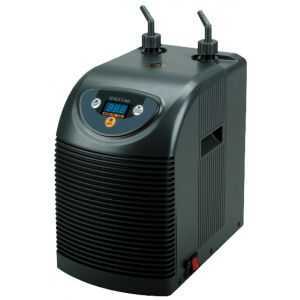
You’ve added nutrients. The next step is water. Keep a few things in mind: the pH of the water, water temperature, and how often you need to change the system’s water. You may want to start with distilled or filtered water. At a minimum, fill your reservoir and let it sit without a cover. Chlorine is added to most tap water, and you don’t want chlorine on your grow. Allow the reservoir to sit without a cover for at least 24 hours, preferably more. It is highly advisable to keep an extra reservoir with water that has been allowed to sit like this in your grow room so that the water is available when needed. Reservoirs should not be translucent – you need to prevent light from penetrating the water so that algae doesn’t grow. Algae can clog your system and use available nutrients that your plants need. It’s easier—and best for your crop— to prevent algae rather than treat your water to rid an otherwise healthy grow of it. Read more about marijuana pH here so that I won’t go into depth here – I’ll mention that the ideal pH is between 5.5 and 6.5. You’ll also need to monitor your water temperature – there are a lot of opinions about what water temp is best, but it is generally agreed that a range of 65 to 75°F (18 to 24°C) is good for your plants. Ideally, you’ll keep the temp on the warmer end of the range for cloning and at the lower end for the grow. If your water temperature is too low, you should be able to correct it with a relatively inexpensive aquarium heater. Water chillers, however, are expensive. If your water temperature is too high, consider all the variables contributing to the higher temperature – your lighting system, air circulation, and air temperature.
Things to consider
- Is your pump motor working too hard or too much (consider cycling 1 minute on, 4 or 5 minutes off)?
- Do you have a reservoir separate from your grow chamber? Can you put your reservoir on the floor (where it is coolest) and have your plants elevated?
Treating your growth as holistically as possible will always help troubleshoot when problems arise. Often, one thing OR another isn’t completely wrong—two, three, or more things are off just a bit.
You are going to need to change your reservoir water to prevent the buildup of salts and to keep your system healthy. Follow the manufacturer’s instructions, monitor your nutrients and pH, and change as often as necessary (depending upon your setup and conditions, this could mean every five days, every week, every ten days – many factors can affect how often the water needs changing.)
Finally, please consider the environment when you dispose of your old reservoir water. The best place to dump your water is in your yard or garden, but not directly on plants (other than grass.) Storm drains in the street take water directly to rivers, streams, lakes, or the sea, and the additional nutrients aren’t good for these bodies of water or the things that live in them. Additionally, sewer systems can’t filter out all the additional nutrients, so they’ll end up in a river or the sea anyway.
Step 5 – Air
Maintaining an optimal room temperature of 70°F (21°C) and keeping the air in your grow room circulating is essential to healthy grow. Well-placed exhaust fans (in addition to any exhaust fans you may have for your lights – depending on the size of your grow room) to pull fresh air into the room (and send the old air outdoors) will bring needed CO2 into your space. CO2 is the lifeblood of any plant, and well-circulating air assists in moving it into your grow space. Speaking of exhaust – you will probably also want to consider how all that expelled air from your grow room will smell. Please don’t overlook the importance of oscillating fans to strengthen stems and help your plants support themselves. Oscillating fans also help prevent mold and keep pests—like whitefly—at bay. Remember that moving so much air will reduce the humidity in your grow room, and you may need to take steps to correct that. You may also use added CO2 to enhance your growth, depending on your budget or other factors.
Step 6 – Growing plants!

You’re almost ready to bring plants into your grow room. Always remember that cleanliness and hygiene are essential to the success of your growth. Start with a tight, clean space before any equipment goes in, clean up after you add each new component to your grow room, and keep your grow room as clean as you would hope your doctor’s office is. Any effort that you can make to ensure cleanliness in your space is a problem that you are preventing.
Prevention is always easier than a cure.
Because aeroponic systems’ designs don’t include support for the canopy—often with a 3 to 6-inch hole in the top of a chamber with roots suspended in the air—you need to consider supporting your plants before you bring those plants into your grow room.
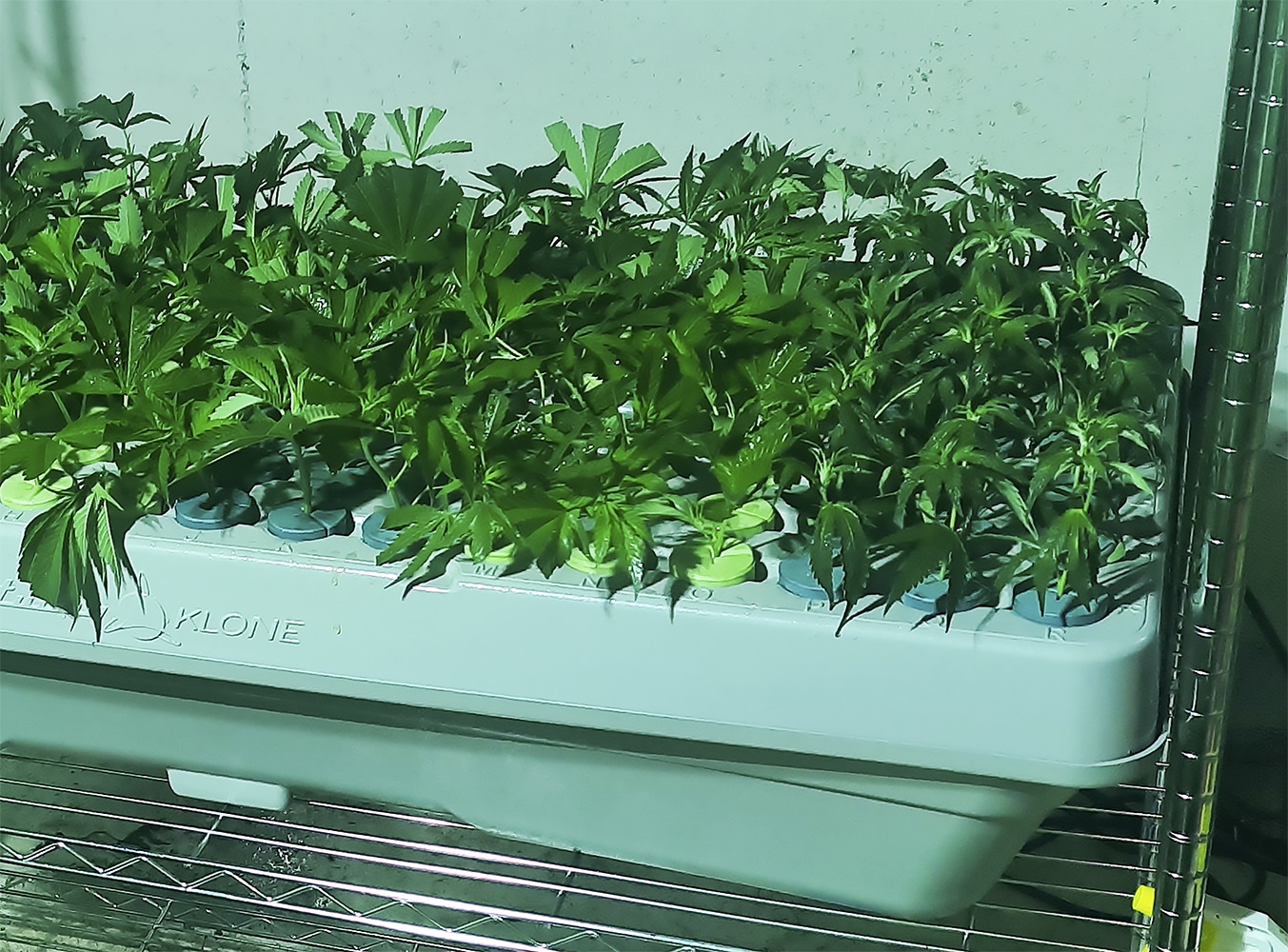
Sea of Green (SOG) and Screen of Green (SCROG) cultivation methods should be considered. Once your plant is 18 inches tall, it will need additional support. Consider the strain you are growing – generally speaking, indica strains don’t grow as tall as sativa strains do. If you want to start your plants from seed, use these instructions for germinating seeds in Rockwool. If you are interested in growing plants from clones, plant the clones in Rockwool, and once they have rooted, plant your cube into some hydroton in your aeroponic system (don’t forget to cap your net pot!) You may be able to forego the hydroton altogether if your pots are small enough.




